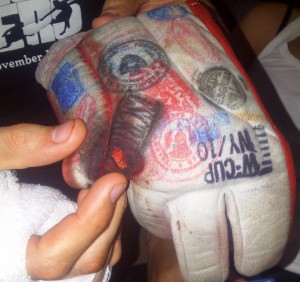
Since 2000 the number of hand and arm injuries in sabre have increased dramatically. These injuries are occurring without broken blades as the unbroken blade pierces the fencers hand or arm to cause the injury.
What is causing these injuries? With the advent of electric sabre, the FIE wanted to reduce the effect of whipover hits in sabre where the tip of the sabre blade could whip around the bellguard and score a hit to the fencers wrist. The decision was made in 2000 to make all sabre blades stiffer so that the whipovers would become less frequent.
Another change that was made had to do with the timing of the scoring lights. The timing for double hits was reduced to 250ms in an effort to reduce the number of actions in which both valid scoring lights would be triggered. The impact of this change was to increase the number of remise actions. Fencers found that they could execute a failed attack, and rather than move back on defense, could execute a remise (or second attack) very quickly and prevent their opponent’s riposte from scoring by locking out the box.
The combination of stiffer blade, increased number of remise actions, and the extended target of the wrist/arm have led to more injuries to the hand/arm area of sabre fencers.
This is not the first time the safety of fencing gloves has been brought into question. In 2010 Tim Morehouse posted an article to his blog after a similar training injury occurred.
In a recent FIE letter, published on March 7th, the FIE noted that multiple injuries have occurred as non broken blades have either pierced the glove or entered through the hole which allows the body wire to pass.
Following the recommendations of the equipment and medical committees, the FIE announced the following preventive measures would be put into place immediately:
1. At all FIE competitions, the gloves will be checked during the initial control of the equipment, as well as in the call room, in order to ensure that they are in very good condition (i.e. without any tears or significant reduction of its thickness); a control mark must be put on all checked gloves.
2. Athletes will have to cover the hole through which the body wire passes, using a strong adhesive band. This taping will be checked by the referee before the beginning of the match.
The FIE realizes that these measures are temporary solutions. To find a long term solution, the FIE has organized a working group to
This group is to be led by M. Giorgio Scarso, and composed of 2 members of the Medical Commission, 2 members from the SEMI commission, 2 manufacturers and 1 athlete.
This Group will study the possible other measures to propose including:
– objective studies made jointly with an institute;
– glove manufacturing standards and modifications;
– guard modifications.
The FIE expects the report from this working group by the end of June 2011.
In the meantime, what can you do to make your sabre fencers safer?
1. Check your gloves for any cuts or holes, especially between the fingers.
2. Minimize the size of the hole in the glove for the body cord. In models with a velcro cuff, make that as tight as possible and for other models use the FIE’s current method and tape up the hole while fencing.
These glove injuries are not limited to sabre fencers. There are a few documented instances of an injury in epee where the unbroken epee point pierces the fencing glove and impales the fencer between the fingers. (pic to right via damianp on the forums)
The injuries of this type that have been documented are from fencers fencing epee with a french grip and “posting”, or pommeling the epee to achieve longer reach.